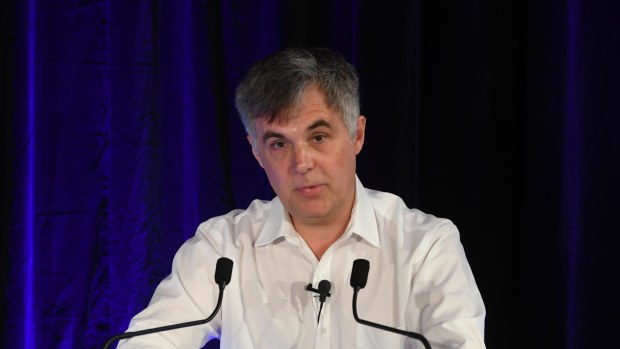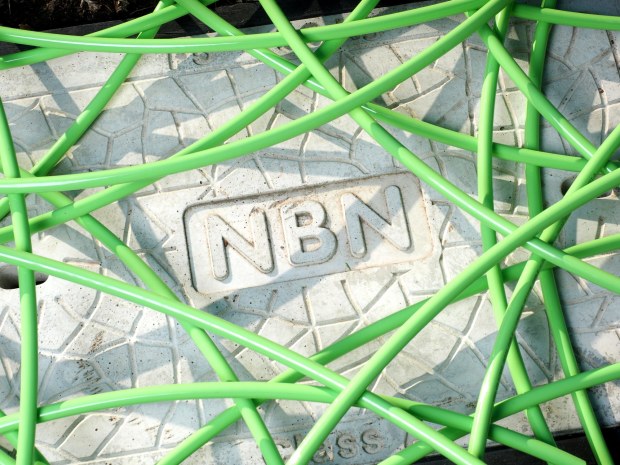NBN Co hopes for enterprise saviour after $2 billion blowout

NBN Co will rely heavily on growth in its fledgling enterprise business to achieve a forecast leap in average revenue per user, as reduced wholesale prices, last year's HFC network pause, and extra fixed wireless investments blew out its budget by $2.2 billion.
The total cost of the National Broadband Network will now be $51 billion, including a $1 billion contingency, and its internal rate of return forecast has been lowered from a range of 3.2 per cent to 3.7 per cent, down to 3.2 per cent.
NBN Co will be forced to borrow the extra cash on the public money market, rather than get it from the government, but gave no timeline for when this would be necessary.

NBN Co chief executive, Stephen Rue said the payback for the investments was better customer experience. Peter Braig
Unveiling his first annual corporate plan as NBN Co chief executive, Stephen Rue said the payback for the investments was better customer experience, with average 'bandwidth congestion' falling from five hours and 23 minutes per week in June 2017, to 25 minutes per week today.
NBN Co defines 'bandwidth congestion' as the amount of time customers suffer speeds which impact their experience, such as buffering of an online video or connection to a website timing out.
NBN Co's offer to retail service providers last December of 50 megabits per second download connectivity for the price of 25 mbps had seen the number of customers on speed plans of 50Mbps or higher increase from 16 per cent in June 2017 to almost 45 per cent.
Mr Rue was confident that people would retain a 50 mbps or higher connection, even as it became more expensive once the NBN Co's offer to wholesalers, knows as 'Focus on 50', expired on October 31.
"When people are getting the quality of service they want at the time they want it, they will want to keep that," Mr Rue told The Australian Financial Review.
However he admitted that much of the forecast growth in average monthly revenue per user from $44 to $51 by 2021-22 would come from NBN Co's relatively new enterprise business.

The total cost of the National Broadband Network will now be $51 billion, including a $1 billion contingency. Shutterstock.com
The one part of the market where it competes head-to-head with other telcos, NBN Co would not provide precise figures on its enterprise penetration but a spokesman said it was currently connecting 20,000 businesses per month. New products like a 1 gigabyte-per-second 'enterprise ethernet' fibre offering are aimed at increasing that number.
The forecast growth in ARPU would be a "challenge" to achieve, said a spokesman for shadow communications minister Michelle Rowland, as it had only increased by $1 in the past two years.
The stall to improve the cable (or HFC) network has put NBN Co way behind its forecast rollout schedule, with 9.7 million premises to be 'ready to connect' by the end of 2018-19, down from the 11.05 million expected in last year's corporate plan.
The completion of the network with 11.6 million premises ready to connect is still scheduled for the end of 2019-20 as per the last corporate plan.
"The NBN is on life support and today's $2 billion cost blowout is nothing short of a disaster," said Ms Rowland.
She called on NBN Co to minimise the amount of fibre to the node (FTTN) deployment wherever feasible, and at a minimum take fibre to the curb (FTTC).
FTTN connections, widely considered inferior to HFC or FTTC, are forecast to remain by the far the largest technology in NBN's mix at its 2020 completion.
Proximity to a node will determine speeds for 4.7 million households, while 2.5 million will have an HFC connection, 1.9 million will have Labor's original conception of a fibre-to-the-premises connection, 1.4 million the FTTC connections which only launched in March, and a further 1 million in regional Australia relying on fixed wireless or satellite connections.
Mr Rue said he was focused on build completion and had no specific plan to ugprade FTTN connections in future.
"But by 2020 we will have provided speeds of at least 25 mbps to everyone and 50mbps or more to 90 per cent of the fixed line footprint, and that is going to have a tremendous impact on the economy," he said.
NBN Co forecasts the National Broadband Network will add $10.4 billion to gross domestic product annually by 2020-21, and will have "enabled" 31,000 extra jobs.
Mr Rue, formerly NBN Co's chef financial officer, did not specifically identify any way in which his strategy would differ from predecessor Bill Morrow.
He said coming into the CEO role two years from build completion, and NBN's emergence as a large network operator, would produce "nuances of style compared to Bill" over time.
Subscribe to gift this article
Gift 5 articles to anyone you choose each month when you subscribe.
Subscribe nowAlready a subscriber?
Introducing your Newsfeed
Follow the topics, people and companies that matter to you.
Find out moreRead More
Latest In Federal
Fetching latest articles